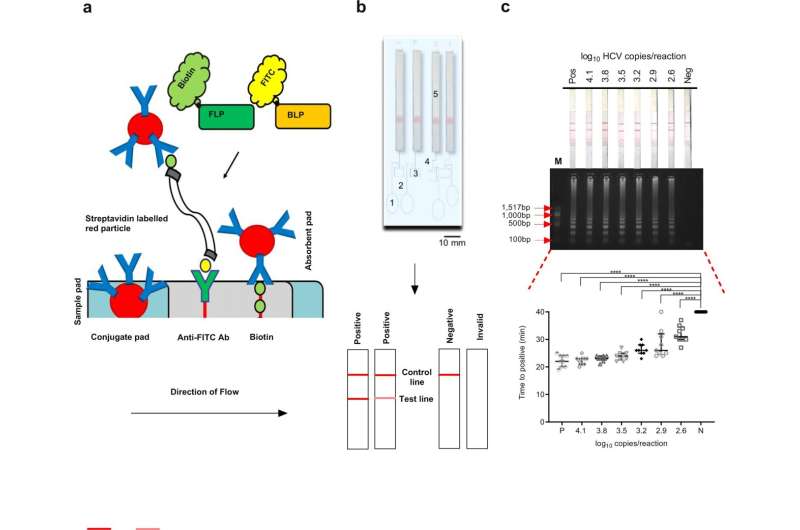'Origami' diagnostic test could help hepatitis C treatment

A new test for hepatitis C which uses origami-style folded paper to deliver fast, accurate and affordable diagnoses could help the global fight against the deadly virus.
The test, developed by biomedical engineers and virologists from the University of Glasgow, delivers lateral-flow results similar to a COVID-19 home test in around 30 minutes.
In a new paper published today in the journal Nature Communications, the research team describe how they developed the system. It builds on previous breakthroughs in rapid diagnostics and virology at the University, delivering results with 98% accuracy.
Hepatitis C, a bloodborne virus which damages the liver, is estimated to affect more 70 million people around the world. The virus' effects on the liver are slow, and patients may not realize they are infected until they become severely ill with complications such as cirrhosis or cancer.
If the infection is detected before it advances significantly, it can be treated effectively with low-cost, readily available medication. However, as many as 80 percent of people with the virus are unaware of their infection until clinical complications occur.
As a consequence, around 400,000 people around the world die from hepatitis C-related illnesses each year, many of whom could have been saved by earlier diagnosis and treatment.
Currently, hepatitis C infections are diagnosed in laboratory conditions using a two-step process which tests blood for the presence of antibodies and detection of the virus' RNA or core antigens.
The process can take a significant amount of time to deliver results, increasing the likelihood that some patients who take the test do not return to learn of the outcome. Access to tests is also limited in low and middle-income countries, where a significant majority of people with hepatitis C live.
While more portable tests capable of delivering rapid results have been developed in recent years, their accuracy can be limited, particularly across different human genotypes.
The University of Glasgow-led team's new system, however, is better-suited for use around the world. It's adapted from a similar system they developed to deliver rapid diagnosis for malaria, which has been tested with encouraging results in Uganda.
The device uses sheets of origami-like folded wax paper to prepare samples for a process known as loop-mediated isothermal amplification, or LAMP. The process of paper folding enables the sample to be processed and delivered to three small chambers in a cartridge, which the LAMP machine heats and uses to test the samples for the presence of hepatitis C RNA. The technique is sufficiently simple that it has the potential, in future, to be delivered in the field, from a blood sample taken from a patient via fingerprick.
The process takes around 30 minutes. The results are delivered through an easy-to-read lateral flow strip like a pregnancy test or a home COVID-19 test, which shows two bands for a positive result and one band for a negative.
To test their prototype, the team used the system to analyze 100 anonymised blood plasma samples from patients with a chronic HCV infection and another 100 samples from HCV-negative patients, which acted as a control group. The samples were also tested using an industry-standard Abbott RealTime hepatitis C assay to confirm the LAMP results. The LAMP tests delivered results which were 98% accurate.
Professor Jonathan Cooper, of the University of Glasgow's James Watt school of Engineering, is one of the paper's co-authors. Professor Cooper said: "The World Health Organisation has published guidelines for the kinds of rapid, accurate diagnostic tests which could help tackle infectious diseases around the world, including hepatitis C.
"Our malaria diagnosis system was a response to that call to action. While that tested patients' blood for the presence of the DNA of Plasmodium falciparum, the mosquito-borne parasitic species which causes malaria, we were confident that it could be adapted for other purposes. We're pleased to have been able to work with our colleagues at the MRC-University of Glasgow Centre for Virus Research to develop this system, which tests for the presence of hepatitis C RNA. The Centre is home to some of the world's leading virologists, and it's been great to have their input and guidance through the development process."
Professor Emma Thomson, of the MRC-University of Glasgow Centre for Virus Research, is also co-author of the paper. Professor Thomson said: "This is a really promising development for the rapid diagnosis of viral hepatitis C, which the WHO is aiming to eliminate by 2030. Sub-Saharan Africa is particularly badly affected by the virus, so a portable, fast test like this one could help a great deal in identifying infections and providing treatment.
"One of the areas of focus for my research group is characterizing the diversity of strains of hepatitis C in Africa, so I was glad to partner with my biomedical engineer colleagues to provide samples and help to make the test more suitable for use in a wide range of settings."
The team are aiming to use the system in field trials in sub-Saharan Africa next year.
The team's paper, titled "Paper microfluidic implementation of loop mediated isothermal amplification for early diagnosis of hepatitis C virus," is published in Nature Communications.
More information: Weronika Witkowska McConnell et al, Paper microfluidic implementation of loop mediated isothermal amplification for early diagnosis of hepatitis C virus. Nature Communications (2021). DOI: 10.1038/s41467-021-27076-z, www.nature.com/articles/s41467-021-27076-z


















